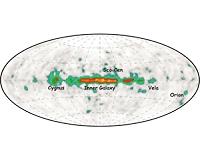 |
Boston MA (SPX) Dec 03, 2010 The biggest galaxies in the universe are elliptical galaxies. The largest of these hold over one trillion stars according to astronomical census takers, compared to 400 billion in our Milky Way. However, new research shows that elliptical galaxies actually hold five to ten times as many stars as previously believed. This means that the total number of stars in the universe is likely three times bigger than realized. The hidden stars are known as red dwarfs for their color and small size. Because red dwarfs are small and dim compared to stars like the Sun, astronomers hadn't been able to detect them in galaxies beyond the Milky Way before now. As such, they didn't know how many stars in the universe were red dwarfs. Scientists used powerful instruments on the Keck Observatory in Hawaii to detect the faint signature of red dwarfs in the cores of eight elliptical galaxies, which are located between about 50 million and 300 million light-years away. They discovered that the red dwarfs, which are only between 10 and 30 percent as massive as the Sun, were much more bountiful than expected. "As it turns out, the universe thinks small, at least when it comes to star size," said Harvard astronomer Charlie Conroy. "Our stellar inventory has changed dramatically." "No one knew how many of these stars there were," said Pieter van Dokkum, a Yale University astronomer who led the research. "Different theoretical models predicted a wide range of possibilities, so this answers a long-standing question about just how abundant these stars are." Their results imply that stellar population counts depend on what type of galaxy astronomers examine, just as a census of the city of New York and the town of Derby, Kansas will find very different population numbers. "We usually assume other galaxies look like our own. But this suggests other conditions are possible in other galaxies," Conroy stated. "This discovery could have a major impact on our understanding of galaxy formation and evolution." In particular, galaxies might contain less dark matter - a mysterious substance only detectable due to its gravitational effects - than previous measurements of their masses indicated. Instead, the abundant red dwarfs might contribute more mass than previously calculated.
Share This Article With Planet Earth
Related Links Harvard-Smithsonian Center for Astrophysics Stellar Chemistry, The Universe And All Within It
 Integral Helps Unravel The Tumultuous Recent History Of The Solar Neighbourhood
Integral Helps Unravel The Tumultuous Recent History Of The Solar NeighbourhoodMunich, Germany (SPX) Nov 30, 2010 Just like archaeologists, who rely on radioactive carbon to date the organic remains from past epochs, astronomers have exploited the radioactive decay of an isotope of aluminium to estimate the age of stars in the nearby Scorpius-Centaurus association, the closest group of young and massive stars to the Sun. The new observations, performed in gamma rays by ESA's INTEGRAL observatory, prov ... read more |
|
| The content herein, unless otherwise known to be public domain, are Copyright 1995-2010 - SpaceDaily. AFP and UPI Wire Stories are copyright Agence France-Presse and United Press International. ESA Portal Reports are copyright European Space Agency. All NASA sourced material is public domain. Additional copyrights may apply in whole or part to other bona fide parties. Advertising does not imply endorsement,agreement or approval of any opinions, statements or information provided by SpaceDaily on any Web page published or hosted by SpaceDaily. Privacy Statement |